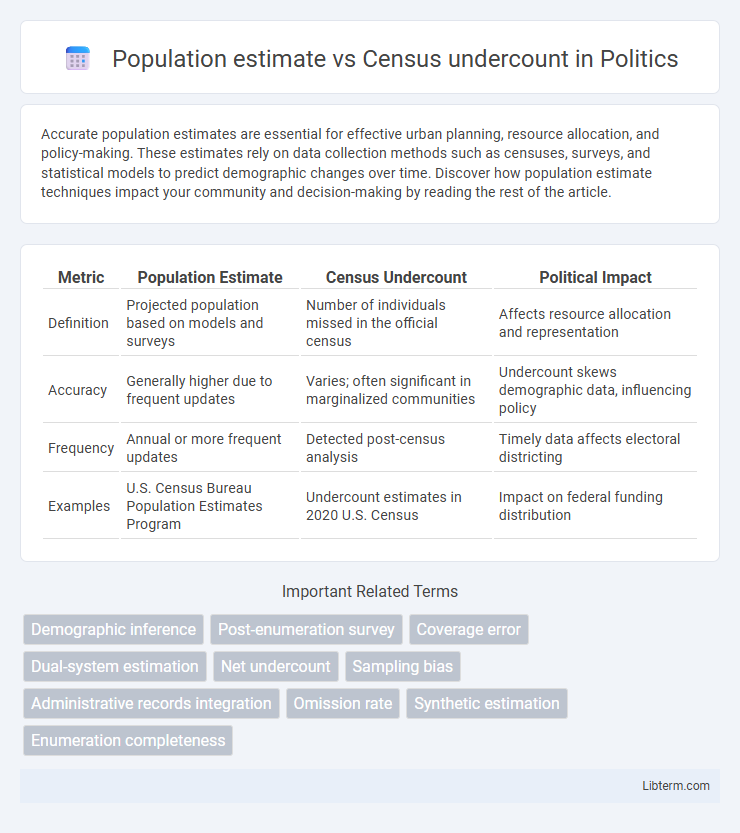Accurate population estimates are essential for effective urban planning, resource allocation, and policy-making. These estimates rely on data collection methods such as censuses, surveys, and statistical models to predict demographic changes over time. Discover how population estimate techniques impact your community and decision-making by reading the rest of the article.
Table of Comparison
| Metric | Population Estimate | Census Undercount | Political Impact |
|---|---|---|---|
| Definition | Projected population based on models and surveys | Number of individuals missed in the official census | Affects resource allocation and representation |
| Accuracy | Generally higher due to frequent updates | Varies; often significant in marginalized communities | Undercount skews demographic data, influencing policy |
| Frequency | Annual or more frequent updates | Detected post-census analysis | Timely data affects electoral districting |
| Examples | U.S. Census Bureau Population Estimates Program | Undercount estimates in 2020 U.S. Census | Impact on federal funding distribution |
Understanding Population Estimates
Population estimates use statistical models and demographic data to project current population size between census years, offering timely insights into demographic changes. Census undercount occurs when certain groups, such as minorities or low-income households, are missed or underreported during the decennial census, leading to inaccuracies. Understanding population estimates involves recognizing their role in adjusting for undercounts and providing more accurate data for policy-making, resource allocation, and planning.
What Is Census Undercount?
Census undercount refers to the phenomenon where the actual population is higher than the number reported in the census due to missed or unrecorded individuals. This discrepancy arises from factors such as hard-to-reach populations, survey non-response, and data collection errors. Accurate population estimates rely on adjusting for census undercount to ensure reliable demographic analysis and resource allocation.
Key Differences: Population Estimates vs Census Undercount
Population estimates rely on statistical models and administrative records to provide timely updates between decennial censuses, while census undercount refers to the number of individuals missed during the actual census enumeration process. Key differences include that population estimates adjust for undercount using demographic analysis and sampling, whereas census undercount represents a direct measurement error impacting data accuracy. Understanding these distinctions is crucial for policymakers to address data gaps and ensure equitable resource allocation.
Methodologies Used in Population Estimation
Population estimation methodologies often include demographic analysis, survey sampling, and administrative records to complement decennial census data. Techniques such as post-enumeration surveys and dual-system estimation adjust for census undercounts by identifying discrepancies between observed and actual populations. These approaches enhance accuracy by accounting for hard-to-count groups and systemic biases inherent in census operations.
Causes of Census Undercount
Census undercount occurs due to factors such as hard-to-reach populations, distrust of government, and transient living situations that limit accurate enumeration. Undercounts are often higher in minority groups, low-income households, and rural areas where access and communication barriers exist. Methodological challenges like outdated address lists and non-response bias also contribute significantly to population estimate discrepancies.
Effects of Undercount on Population Data
Population estimates are frequently adjusted to compensate for census undercount, which occurs when certain demographic groups are missed during data collection. Undercounting distorts population data, leading to inaccurate resource allocation, misinformed policy decisions, and flawed demographic analyses. Accurate adjustments are critical for ensuring equitable representation and effective planning in public services.
Impacts on Policy and Resource Allocation
Population estimates and census undercounts significantly influence policy decisions and resource allocation by affecting the accuracy of demographic data essential for government planning. Undercounting marginalized groups leads to misallocation of funding for public services such as healthcare, education, and infrastructure, disproportionately impacting community development and social equity programs. Reliable population estimates optimize budget distribution, ensuring that legislative representation and social support systems reflect the true population needs.
Addressing Census Undercount Challenges
Census undercount occurs when certain populations are systematically missed during data collection, leading to inaccurate population estimates that affect resource allocation and policy decisions. Addressing census undercount challenges involves deploying advanced data integration techniques, utilizing administrative records, and implementing targeted outreach programs to improve participation among hard-to-count groups. Enhancing enumeration strategies with geospatial technology and community partnerships ensures more accurate demographic data and reduces disparities in census coverage.
Improving Population Data Accuracy
Population estimates rely on statistical models predicting demographic changes between census years, while census undercount occurs when certain populations are systematically missed during the enumeration process. Improving population data accuracy involves integrating administrative records, using advanced geospatial technologies, and conducting targeted outreach to underrepresented communities. Enhanced data validation methods and real-time analytics help reduce discrepancies and provide more reliable population metrics for policy-making and resource allocation.
The Future of Population Measurement
Population estimates utilize statistical modeling and survey data to adjust for census undercount, providing more accurate demographic insights essential for policymaking. Advancements in big data analytics, machine learning, and real-time administrative records are transforming population measurement by enabling dynamic updates and reducing reliance on decennial census counts. Integrating diverse data sources enhances the precision of population estimates, supporting better resource allocation and planning for future demographic changes.
Population estimate Infographic

 libterm.com
libterm.com